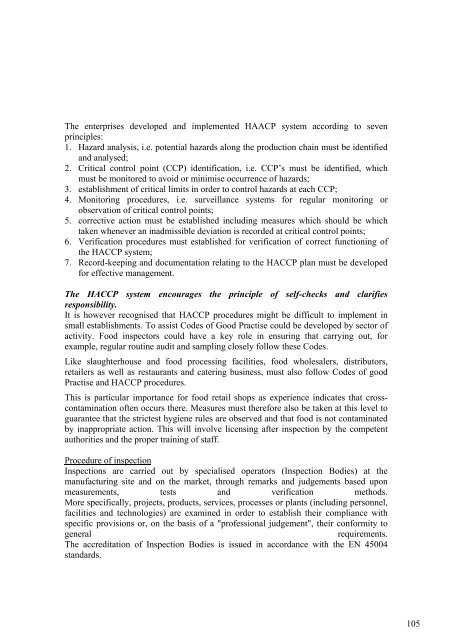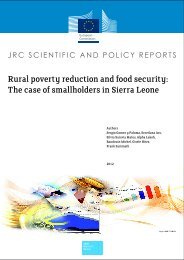(DG JRC/IPTS) - agrilife - Europa
(DG JRC/IPTS) - agrilife - Europa
(DG JRC/IPTS) - agrilife - Europa
Create successful ePaper yourself
Turn your PDF publications into a flip-book with our unique Google optimized e-Paper software.
The enterprises developed and implemented HAACP system according to seven<br />
principles:<br />
1. Hazard analysis, i.e. potential hazards along the production chain must be identified<br />
and analysed;<br />
2. Critical control point (CCP) identification, i.e. CCP’s must be identified, which<br />
must be monitored to avoid or minimise occurrence of hazards;<br />
3. establishment of critical limits in order to control hazards at each CCP;<br />
4. Monitoring procedures, i.e. surveillance systems for regular monitoring or<br />
observation of critical control points;<br />
5. corrective action must be established including measures which should be which<br />
taken whenever an inadmissible deviation is recorded at critical control points;<br />
6. Verification procedures must established for verification of correct functioning of<br />
the HACCP system;<br />
7. Record-keeping and documentation relating to the HACCP plan must be developed<br />
for effective management.<br />
The HACCP system encourages the principle of self-checks and clarifies<br />
responsibility.<br />
It is however recognised that HACCP procedures might be difficult to implement in<br />
small establishments. To assist Codes of Good Practise could be developed by sector of<br />
activity. Food inspectors could have a key role in ensuring that carrying out, for<br />
example, regular routine audit and sampling closely follow these Codes.<br />
Like slaughterhouse and food processing facilities, food wholesalers, distributors,<br />
retailers as well as restaurants and catering business, must also follow Codes of good<br />
Practise and HACCP procedures.<br />
This is particular importance for food retail shops as experience indicates that crosscontamination<br />
often occurs there. Measures must therefore also be taken at this level to<br />
guarantee that the strictest hygiene rules are observed and that food is not contaminated<br />
by inappropriate action. This will involve licensing after inspection by the competent<br />
authorities and the proper training of staff.<br />
Procedure of inspection<br />
Inspections are carried out by specialised operators (Inspection Bodies) at the<br />
manufacturing site and on the market, through remarks and judgements based upon<br />
measurements, tests and verification methods.<br />
More specifically, projects, products, services, processes or plants (including personnel,<br />
facilities and technologies) are examined in order to establish their compliance with<br />
specific provisions or, on the basis of a "professional judgement", their conformity to<br />
general requirements.<br />
The accreditation of Inspection Bodies is issued in accordance with the EN 45004<br />
standards.<br />
105

















